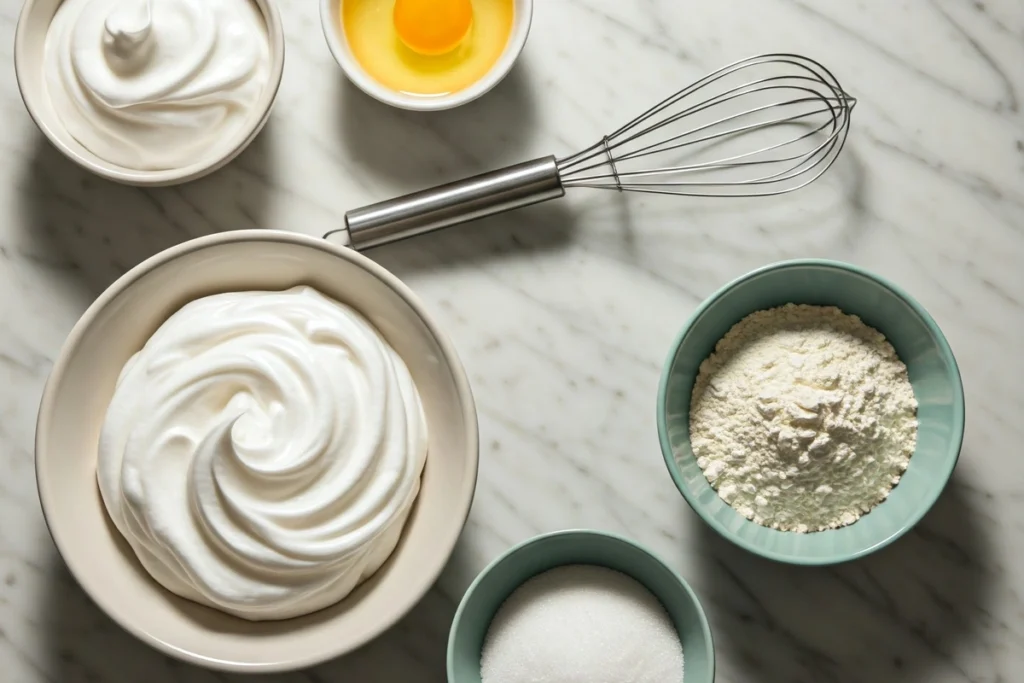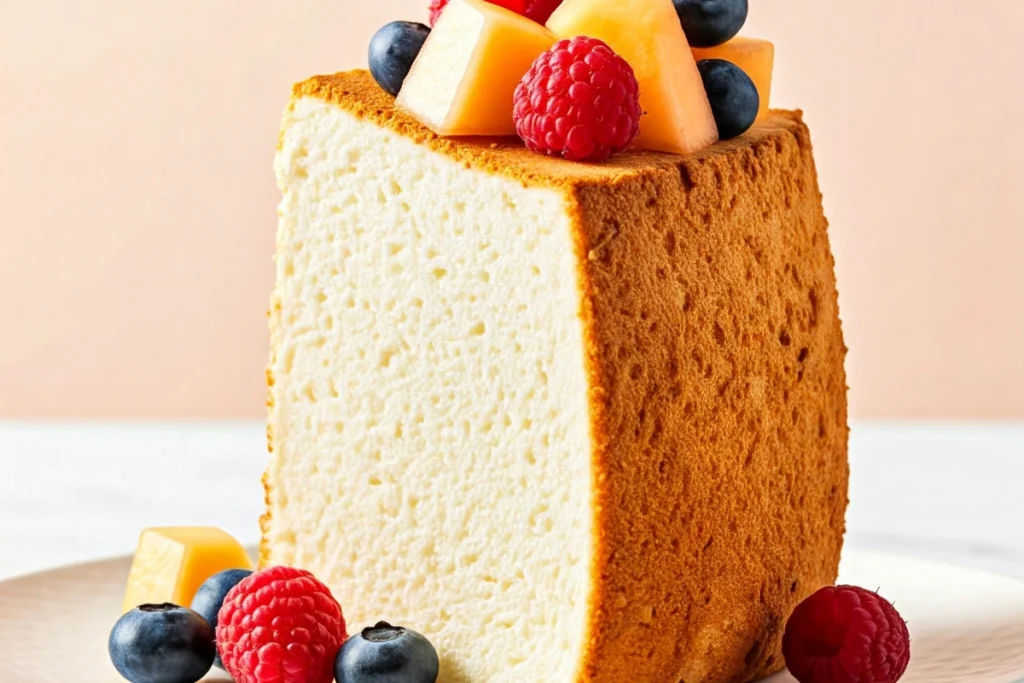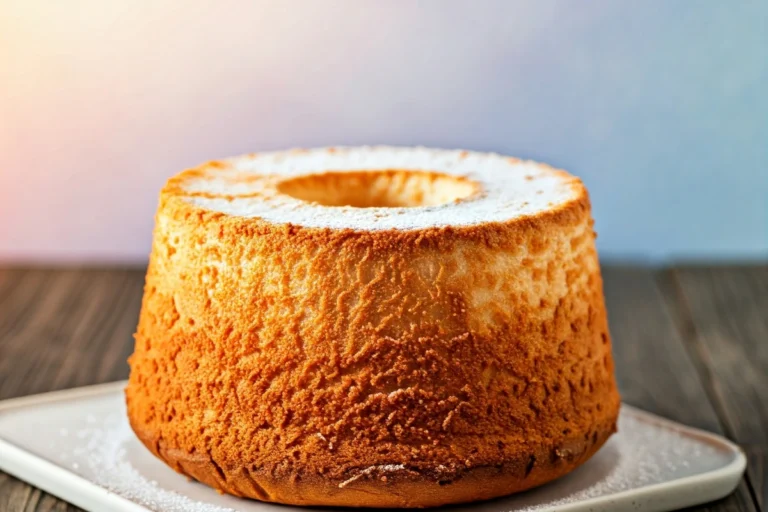Experience the airy magic of angel cake, uncover its core ingredients, and learn the secrets to baking this timeless dessert.
Angel cake is a classic treat that many people adore. It has a delicate texture, a light flavor, and a delightful appearance. Moreover, it stands out because it uses no heavy fats. Consequently, countless bakers rely on whipped egg whites to give it that signature fluffy quality. Indeed, this dessert often appears at celebrations across the country. Altogether, it remains a prime choice for those who prefer a dessert that feels less dense than other options. However, you might be wondering why it has such a special consistency. Basically, it all comes down to the right ingredients and careful mixing.
Because of its popularity, you might ask yourself, What is angel cake made of? People commonly believe that this dessert only contains egg whites and sugar. Nonetheless, subtle variations often exist. Another factor that contributes to the cake’s success involves technique. Specifically, you should master how to handle whipped egg whites. Furthermore, the way you fold your dry ingredients into your foamed egg whites matters greatly. Comparatively, if you stir too aggressively, you lose the lightness. Conversely, if you fold too gently, lumps might form. Therefore, skillful blending is essential.
Below, you will find a detailed discussion of every component. Equally, we will look at the role each plays. Eventually, you will learn how to create the perfect texture. Additionally, we will examine helpful baking tips and serving suggestions. What is angel cake made of? is a question that deserves a comprehensive answer, which we will provide through various sections. By the end, you will have a clear blueprint for assembling and serving an impressive angel cake at home.
What Is Angel Cake Made Of? Key Ingredients Overview
When you ask, What is angel cake made of? you are essentially asking about what makes this dessert so airy. Chiefly, egg whites, sugar, and flour make up the foundation. Nevertheless, each plays a specific role in achieving a moist, cloud-like crumb. Let’s take a closer look at these components.
- Egg Whites: These create the fluffy base. Initially, they get whipped into a stable foam, trapping air bubbles inside. Undoubtedly, this step delivers the cake’s lift and airy crumb.
- Sugar: This sweetens the batter and stabilizes the whipped egg whites. Particularly, superfine sugar dissolves more easily, producing an even texture.
- Flour: Some recipes use cake flour. Because of its lower protein content, it ensures a tender result. However, all-purpose flour can still work if handled properly.
Meanwhile, other elements bring subtle flavor boosts. Vanilla extract and a pinch of salt often appear. Occasionally, a small bit of cream of tartar helps stabilize the meringue. Altogether, these ingredients allow your angel cake to reach its full, dreamy potential.
Furthermore, the quality of each item matters. Fresh egg whites whip more efficiently. Likewise, sifting the flour removes lumps and keeps the final mixture smooth. Consequently, a well-chosen flour type contributes to a cloud-like crumb that melts in your mouth. Comparatively, ignoring these details can lead to a dense outcome. Therefore, always pay attention to freshness, measuring accuracy, and sifting.
What Is Angel Cake Made Of? Egg Whites’ Contribution
When someone inquires, What is angel cake made of? they usually want to understand how egg whites contribute. Essentially, egg whites form the backbone of your cake’s structure. Initially, you whip them until they create stiff peaks. This process traps air, transforming liquid egg whites into a solid foam. Particularly, small pockets of air get locked in the meringue, giving angel cake its signature height.
Eventually, these whipped egg whites bind with the flour. In addition, sugar blends seamlessly into the foam, balancing sweetness. Consequently, the final batter becomes smooth. Another trick is to add cream of tartar or lemon juice. This step boosts the foam’s stability. Meanwhile, you should avoid over-whisking. Over-whipped whites can collapse, creating dryness or a rubbery texture. Thus, timing and technique become essential.
Finally, remember to keep your mixing bowl grease-free. Even a tiny bit of fat can prevent egg whites from whipping properly. Similarly, ensure no egg yolk sneaks into the whites. Indeed, proper care at this stage will give your cake its best possible rise. Undoubtedly, the egg whites are what make this dessert so iconic.

What Is Angel Cake Made Of? The Role of Sugar
Often, people focus on egg whites. Nonetheless, sugar is equally important. When you ask, What is angel cake made of? you should note that sugar acts as both a sweetener and a stabilizing agent for the meringue. Comparatively, too little sugar weakens your foam. Conversely, too much sugar might make the batter heavy. Therefore, balancing sugar content is crucial.
Because superfine sugar dissolves quickly, it mixes more evenly with the egg whites. Eventually, you can incorporate it in stages. Initially, you begin whipping egg whites on low speed. Then, gradually add sugar to maintain a stable foam. Furthermore, sugar crystals help the protein strands in egg whites bond more effectively. Equally, the final texture relies on a perfect sugar-to-egg-white ratio.
Also, consider taste preferences. Some recipes might use less sugar. Others call for additional sweeteners like confectioners’ sugar in the garnish. However, classic angel cake typically involves a specific sugar quantity for best results. Moreover, you can shift sugar amounts slightly if you plan to top the cake with a very sweet icing or fresh fruit.
What Is Angel Cake Made Of? Flour and Flavorings
When you continue asking, What is angel cake made of? the final major piece often includes flour. Cake flour is typically recommended. Basically, it has a finer consistency and reduced protein content, which leads to a lighter crumb. However, sifting the flour beforehand is essential to avoid lumps and ensure even distribution. Consequently, the batter incorporates easily. Undoubtedly, smooth blending means a more uniform texture.
Additionally, flavorings like vanilla extract or almond extract can play a key role. While traditional angel cake often uses vanilla, you can experiment with other options. Indeed, citrus zest or subtle flavors like lemon or orange essence add extra brightness. Meanwhile, a pinch of salt rounds out sweetness. Thus, each flavoring adds depth without overpowering the delicate structure.
Finally, you might consider small inclusions such as finely grated coconut or a hint of spice. Nevertheless, add them in moderation. Excessive weight can flatten the airy foam. Equally, you want to preserve the signature cloud-like crumb. Therefore, mindful experimentation is welcome.
What Is Angel Cake Made Of? Step-by-Step Preparation
Let’s outline how to assemble your batter using the tried-and-true approach. Hence, you will gain a practical perspective on the question, What is angel cake made of?
- Gather Ingredients: Measure egg whites, sugar, flour, cream of tartar, vanilla, and salt.
- Preheat Oven: Typically, 325°F (163°C) works best.
- Whip Egg Whites: Begin on low speed, adding cream of tartar.
- Gradual Sugar Addition: Increase the mixer speed to medium. Slowly pour sugar into the foam.
- Sift and Fold: Sift the flour and salt together. Fold them gently into the whipped egg whites.
- Add Flavor: Stir in vanilla or other preferred extracts.
- Bake: Pour batter into an ungreased tube pan. This helps the cake climb the walls of the pan. Bake until golden, usually around 35 minutes.
- Cool Upside Down: Invert the pan to prevent the cake from collapsing.
Specifically, the final step keeps the airy structure intact. Indeed, letting the cake cool upside down is a key tradition. Ultimately, that’s how you preserve its height. Because angel cake has no heavy fats, it can sink if you place it upright too quickly. Conversely, cooling in an inverted position maintains its lofty shape.
Variations and Toppings
Now that you know what is angel cake made of? you can consider variations. The classic version remains popular for good reason. Nonetheless, a few custom touches can personalize your dessert. For instance, you might add a small amount of cocoa powder for a light chocolate note. Another approach is to swirl in gentle fruit purees. Strawberries or raspberries bring bursts of color and tanginess.
Meanwhile, toppings also matter. Generally, angel cake pairs well with fresh fruit and whipped cream. Likewise, a dusting of powdered sugar offers a delicate finish. Additionally, fruit sauces like strawberry, blueberry, or lemon curd complement the cake’s subtle sweetness. However, avoid applying heavy icing, as it might weigh down the cake’s airy crumb. Nonetheless, a thin glaze made of citrus juice and powdered sugar can add shine and flavor without ruining the texture.
Serving and Storage
Once your cake has cooled, you can run a knife around the pan’s edges to release it. Slide it out gently. Then, flip it onto a platter. Therefore, you maintain its shape. Meanwhile, you can choose your garnish. Fresh berries remain a crowd favorite. Another option is a light drizzle of flavored glaze. Conversely, you might enjoy it plain. Many appreciate angel cake for its simple sweetness and airy crumb.
For storage, wrap leftover slices in plastic or use an airtight container. Ideally, keep them at room temperature for up to two days. Eventually, you can place slices in the refrigerator for an additional day or two, but the cake may dry out slightly. Nevertheless, some people prefer the chilled texture. If dryness occurs, pair it with fruit or whipped cream. Consequently, you can restore some of that softness.
Finally, if you want to freeze angel cake, slice it first. Then, wrap each piece in plastic wrap and place them all in a freezer-safe container. They can remain frozen for up to three months without significant flavor loss. Altogether, storing your angel cake properly ensures you can enjoy it over multiple days or even weeks.

Tips for Perfect Results
- Separate Eggs Carefully: Even a tiny trace of yolk affects your foam.
- Room Temperature: Warm egg whites whip to a higher volume.
- Clean Equipment: Grease-free bowls and whisks are vital for perfect aeration.
- Gentle Folding: Avoid deflating the batter while incorporating dry ingredients.
- Patience: Do not rush the baking time or open the oven door prematurely.
Furthermore, practice makes perfect. Initially, you may find it challenging to judge the correct whipping stage. Eventually, you will develop a feel for the subtle changes in texture. Accordingly, you can refine your method. In addition, write down notes after each attempt. This record can help you fine-tune future bakes. Thus, your angel cake will improve over time.
Frequently Asked Questions (FAQs)
Below, you will find common queries about angel cake. People often want to know more details after asking, What is angel cake made of? This section addresses those points further.
Q1: Can I use all-purpose flour instead of cake flour?
Yes, you can. However, cake flour generally produces a lighter texture. If all-purpose flour is your only option, sift it multiple times. Consequently, you get a finer consistency. Additionally, consider removing one or two tablespoons of flour per cup, then replacing them with cornstarch. This modification approximates cake flour’s texture.
Q2: Why is my angel cake too dense or heavy?
A heavy texture often occurs if you overmix the batter or deflate the egg whites. Likewise, adding sugar too quickly can destabilize your foam. Another possibility is using an under-whipped meringue. Ensure your peaks are stiff but not grainy before folding in the flour. Altogether, gentle handling preserves the cake’s airy crumb.
Q3: Can I flavor my angel cake with citrus?
Absolutely. For a fresh twist, add lemon or orange zest when you incorporate flavorings. Another option is to use a tiny amount of lemon or orange extract. Just remember, strong flavors might overwhelm the cake’s delicate sweetness. Therefore, add them gradually. Eventually, you will find your perfect flavor balance.
Q4: How do I keep my angel cake from collapsing?
You should invert the cake pan immediately after baking. Let it cool upside down for at least one hour. This method keeps the structure intact. Additionally, ensure your egg whites are properly whipped. Conversely, an under-whipped foam might not have enough volume to remain stable. Moreover, keep the oven door shut until baking is nearly complete. Sudden temperature drops can make the cake sink.
Q5: Is angel cake suitable for people limiting fats in their diet?
Yes. Since it contains no butter or oil, angel cake is relatively low in fat. Nonetheless, it can still have a considerable sugar content. Therefore, consume it in moderation if you are monitoring your sugar intake. Pair it with fresh fruit for a healthier spin.
Q6: Can I freeze leftover angel cake?
Yes, you can freeze slices individually. Wrap them well in plastic and place them in a freezer-safe container. They should last about three months. Thaw at room temperature for about 30 minutes. Accordingly, you can enjoy a convenient slice whenever you like.
Because angel cake is light, versatile, and relies heavily on whipped egg whites, it remains a longstanding favorite among dessert enthusiasts. Indeed, the central question, What is angel cake made of? includes an array of important details, from eggs to sugar ratios. Nevertheless, the key lies in proper technique and a delicate touch throughout. Consequently, once you master these methods, you can enjoy this timeless dessert anytime.
Altogether, angel cake offers an elegant finish to any meal. Indeed, its soft crumb complements various toppings, from fresh fruit to light glazes. Finally, this dessert stands as a delightful testament to the magic of simple ingredients used with care.

